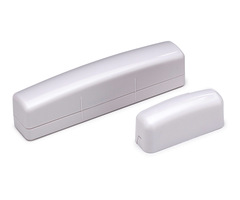What Is the Difference Between Slim Line and Regular Alarm Sensors?
The difference between slim line and regular alarm sensors is that slim line sensors are thinner. These thinner sensors can be better for applications where space is limited. Both sensor types work the same otherwise. However, slim line sensors often have a shorter wireless signal range.
 The most common type of security sensors that come in a slim line variety are door and window contacts. These devices consist of two parts - a sensor and a magnet. The sensor is mounted on the stationary frame of the door or window. The magnet is mounted on the moving portion of the door window, within a half-inch of the sensor. When the door or window is opened, the magnet will separate from the sensor. This will cause a reed switch inside the sensor to activate . Once this happens, the sensor will send an alert to the panel to let it know that the door or window has been opened.
The most common type of security sensors that come in a slim line variety are door and window contacts. These devices consist of two parts - a sensor and a magnet. The sensor is mounted on the stationary frame of the door or window. The magnet is mounted on the moving portion of the door window, within a half-inch of the sensor. When the door or window is opened, the magnet will separate from the sensor. This will cause a reed switch inside the sensor to activate . Once this happens, the sensor will send an alert to the panel to let it know that the door or window has been opened.
Certain types of doors and windows only have a limited amount of space where a sensor and magnet can be installed. This space might be too limited to support a regular-sized sensor. In those situations, the best solution can be to use a slim line door and window contact with a thinner profile. This way, the magnet and sensor can be properly aligned when the door or window is closed. This will ensure that the device provides proper function. Some of the slim line contacts sold by Alarm Grid include the Honeywell 5820L and the DSC EV-DW4975. Make sure that any sensor you purchase is compatible with your security system.
There is one very important consideration to make when using slim line wireless door and window contacts. These thinner sensors often have shorter wireless signal ranges than standard-sized sensors. This is because the slim line sensors usually have smaller antennas. Most of the time, the difference is not large enough that it will cause any major issues. But for users who plan on using their sensors from a far distance from the wireless receiver, slim line sensors might not always represent the best option. Keep in mind though that a wireless repeater can often be used to extend the maximum distance if wireless range is a concern. An example of a wireless repeater is the Honeywell 5800RP.
Did you find this answer useful?
We offer alarm monitoring as low as $10 / month
Click Here to Learn MoreRelated Products

- Answered
